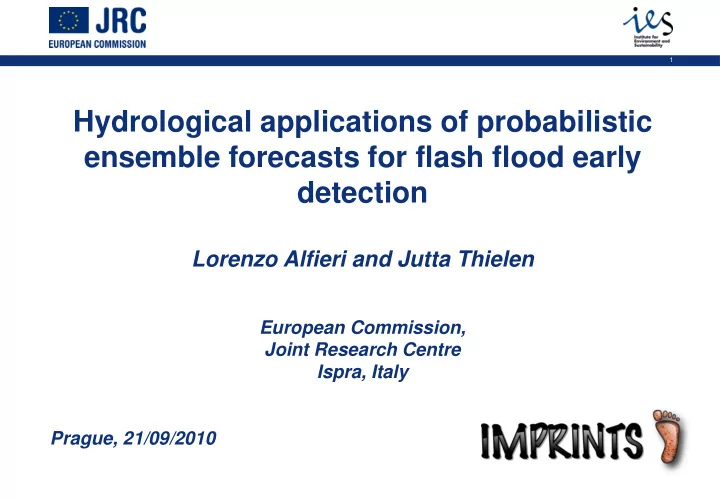

1 Hydrological applications of probabilistic ensemble forecasts for flash flood early detection Lorenzo Alfieri and Jutta Thielen European Commission, Joint Research Centre Ispra, Italy Prague, 21/09/2010
Introduction 2 Atrani – 9/9/2010 EC-FP7 Project IMproving Preparedness and RIsk maNagemenT for flash floods and debriS flow events WHAT: Improve flash flood early detection HOW: Hydrological simulation of probabilistic ensemble forecasts (EPS) • Performance analysis from 3 predictors derived from the EPS – Quantitative estimation – Threshold exceedance analysis (Important for Early Warning) – Influence of forecast persistence What is the best predictor to use in (flash) flood Early Warning?
Meteorological data 3 – COSMO-LEPS 10 km : 7/2008 - 11/2009, 3- hourly, 10 km grid, 16 members , lead time = 5.5 days. – COSMO-LEPS 7 km : From 12/2009, 3-hourly, 7 km grid, 16 members, lead time = 5.5 days. – 30-year Climatology : (1971-2000), 3-hourly, 10 km grid resolution,1 member from ECMWF EPS control run (Source: COSMO Consortium)
Hydrological simulation 4 Initial conditions Static maps, 1 km resolution (whole Europe) Meteo data (COSMO-LEPS) LISFLOOD model (Van der Knijff et al., 2010) Output discharge
Case study 5 17-month simulation (Jul 2008 - Nov 2009) with COSMO-LEPS 10 km Verzasca (CH) Area = 186 km 2 Comparison of simulated ensemble hydrographs with hourly discharge observations, for different forecast lead times (1 to 5 days).
Search of the optimal predictor 6 1. Sample quantiles of the ensemble (EPS) 2. Ensemble mean (EPS mean) 3. Fitting of a probability distribution to the EPS (Gamma) Gamma distribution with L-moments fit (Hosking and Wallis, 1997) Advantages Drawbacks Use of the original EPS Little robust, especially in the EPS sample quantiles lowest/highest quantiles EPS mean Very robust, it considers Deterministic prediction, no info all the members on uncertainty/spread of EPS Probabilistic forecast. Additional uncertainty due to Gamma Robust fitting a probability distribution
Comparison of the predictors 7 EPS fitted distribution
Quantitative discharge estimation 8 MSE(x) = Var(x) + bias 2 (x) Resolution Reliability x = (Q FCST – Q SIM ) bias 2 (x) Var(x)
Discharge estimation - High flow 9 Threshold = 0.3 Lead Time Lead Time Lead Time 1 day 3 days 5 days bias 2 (x) Var(x)
Threshold exceedance analysis 10 FULL SET HIGH FLOWS Threshold = 0.3
Persistence of forecasts 11 Single Two consecutive forecast forecast Threshold = 0.3 Threshold = 0.5
Conclusions 12 • A framework aimed to operational probabilistic flash flood early warning is being tested. The adopted methodology is derived from that of the European Flood Alert System (EFAS) • Current NWPs give useful support in flash flood forecasting, though some limitations are found in quantitative discharge estimation (extreme events). • Fitting a (gamma) probability distribution to the hydrologic EPS leads to significant improvements, particularly in the threshold exceedance analysis • Persistence of forecasts improves the early detection of (flash) floods, especially for short lead times. • The EPS mean is however a robust and quite accurate (deterministic) predictor
13 Hydrological applications of probabilistic ensemble forecasts for flash flood early detection Lorenzo Alfieri and Jutta Thielen European Commission, Joint Research Centre Ispra, Italy Prague, 21/09/2010
Flash Flood Warning 14 PRECIPITATION-BASED INDICATOR HYDROLOGICAL SIMULATION (COSMO-LEPS) (CATCHMENT SCALE) = WARNING THRESHOLD EXCEEDANCE ANALYSIS + PERSISTENCE
Recommend
More recommend